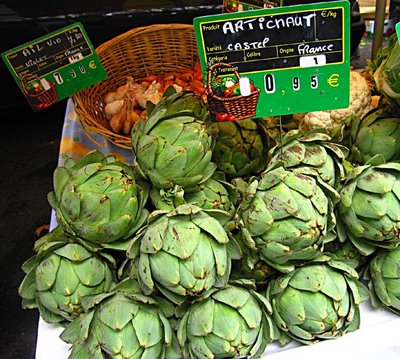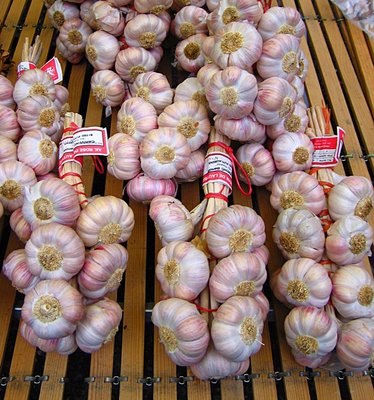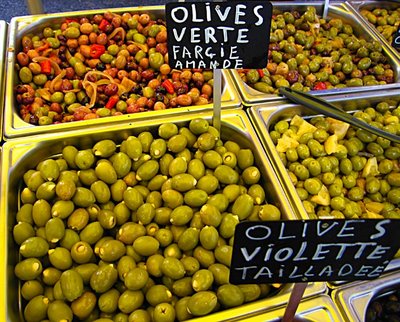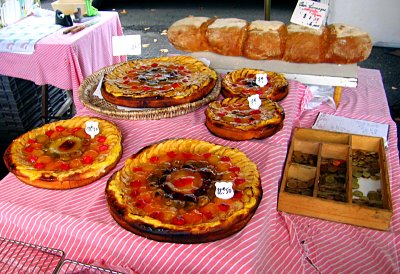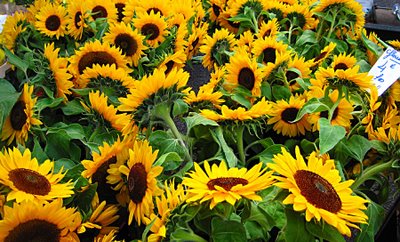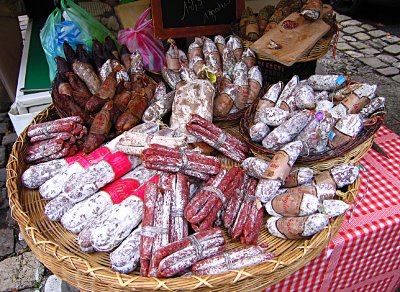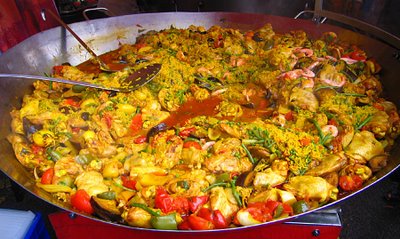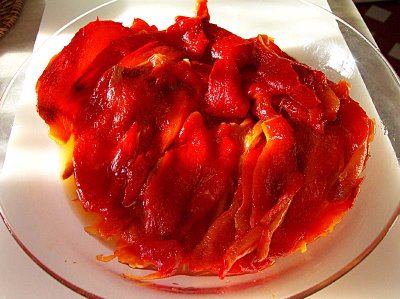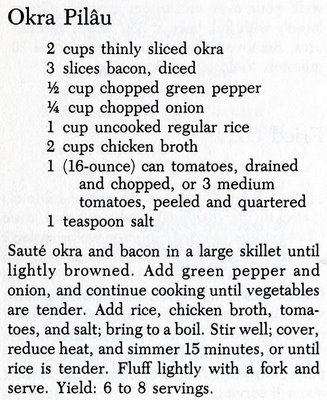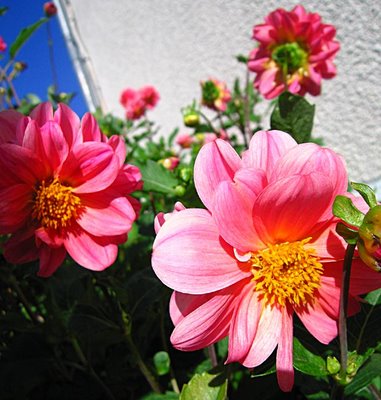Monday evening, Gabby and Margaret had dinner at the Grand Hôtel de Saint-Aignan, where they were staying. Walt and I stayed in and ate our chicken tarragon leftovers.
Tuesday morning, Gabby called and said she and M. had decided to go do some laundry at Saint-Aignan's new laundromat. It went really well, they said, even though it was a little complicated. You have to put your clothes and soap in the washer and then go to a central pay station to put in your coins. If you accidentally press the wrong button, you start the wrong washer and then you are in a pickle. But our friends said they had no trouble.
Another woman came in to do a big load of laundry in a machine that cost 15 euros to run. That's a lot of laundry. She put her clothes and soap in, went to the pay station and deposited her coins, pressed the button, and ... nothing happened. She asked Gabby and Margaret for help and advice, but there was nothing they could do. The woman finally had to call the phone number posted in the laundromat and ask an attendent to come figure it all out. After a while, somebody showed up and got the machine to work.
Another customer came in. It was an older gentleman that Gabby and Margaret had seen walk by the hotel earlier in the morning. He was carrying a little squeaky toy in his hand and squeezing it to make it squeak. Our friends looked to see if he was walking a dog, but there was no canine in sight. The man seemed just slightly eccentric. And now here he was in the laundromat.
He asked Gabby if she could help him figure out the machines, and she did. Another woman, this one with a small child, came in and was waiting for a washing machine. The man had the squeaky toy in his pocket, but every once in a while he would put his hand in there and squeeze the toy. The child was fascinated, Gabby said.
Soon the laundry was done and Gabby and Margaret took their clean clothes back to the hotel. For lunch they went to a restaurant just down the street on the riverfront, L'Embarcadère, and had an omelette.
Meanwhile, Walt and I spent the morning at home catching up on our reading and blogging. The plan was to go out to dinner with Gabby and Margaret that evening. We wanted to go to what is probably the nicest restaurant in Saint-Aignan, Le Mange-Grenouille (The Frog-Eater). Walt looked up the restaurant's web site and learned that it is closed on Tuesday evening and all day Wednesday. We were out of luck.
Now we already knew that two of our favorite Saint-Aignan restaurants, Le Crêpiot and L'Amaréna, were closed for most of September (fermeture annuelle). The owners take their vacation after the busy tourist season (July and August) is over.
Our next idea was L'Embarcadère, but then I talked to Gabby and found out they had just had lunch there. And they had had dinner the night before at the Grand Hôtel's restaurant. So we decided to find another place. I called a restaurant called Le Relais de Chasse and got a man on the phone who said it was closed for good — he had retired. We looked up the local restaurant called Chez Constant on the Internet, and it too is closed on Tuesdays.
I guess it is not a good idea to try to go out for dinner in Saint-Aignan on Tuesdays, at least in September.
Finally I called a place over in the village of Thésée, about five miles from Saint-Aignan. It's called Le Moulin de la Renne (Reindeer Mill) and it's a Logis de France address. It was open Tuesday night.
And it was a little bit of a disappointment, I thought. The main menu included three main dishes: coq au vin, aile de raie (skate wing), and andouillette (a sausage made with pigs' intestines). The coq au vin would have been, to a person, our choice for dinner, but the restaurant had run out. Walt ended up having the skate wing, and I think it was pretty good. The other three of us dropped back to the less expensive menu touristique, which featured truite au gratin (trout with a broiled cheese topping) and a pièce de bœuf (a steak).
I had the steak and it was fine. Gabby and Margaret had the trout, and they said it was OK. That was faint praise. Our appetizers and desserts were fine but not spectacular. G. and M. each had a crème brûlée, I remember.
The restaurant was featuring wines from the winemaker next door, and those were very good. We had a Touraine Cabernet 2004 (12 euros for a bottle) and a Touraine Sauvignon Blanc 2005 (11 euros).
There were three other people having dinner in the restaurant that night. Two older men were at one table. They left before we did, and they took their half-empty bottle of sparkling mineral water with them when they exited. A younger woman was dining alone and reading a magazine. She left without my noticing. The place was very quiet.
The walls of the dining room were covered with dark, shiny, fairly primitive paintings by local artists, some of which had a distinct nautical theme (though we are far from the coast). One large canvas over a fireplace featured a very busty topless woman. And one painting was a portrait of the restaurant owner's dog, an enormous, very friendly Bernese mountain dog (bouvier bernais).
The owner himself was a fairly disheveled middle-aged man who definitely looked rural. His fingernails were not very clean. But he was friendly and the service was fine. At dessert time, a woman chef came to the table to set the crème brûlée desserts alight with a match and some citrus-flavored liqueur. She was probably the waiter's wife.
21 September 2006
19 September 2006
Villages near Loches
Walt just posted on his blog a topic about our Sunday night dinner with Gabby and Margaret. The tarragon chicken, roasted peppers, goat cheeses, and fig tarts were excellent.
We spent yesterday (Monday) morning getting some details for the rest of G. and M.'s travels sorted out. That involved a trip to the train station over in Noyers (about 4 miles from our house) which was inconclusive. We came back over to the house and did some Internet work to see what train schedules would be best. We found just what G. and M. wanted, so we went back over to the train station and bought the tickets.
After that, we came back to the house for lunch. We had duck and goose rillettes (which are shredded, potted meat that you eat cold on bread with the little pickled gherkins called cornichons). We had goat cheese (of course). We had some roasted red peppers (of course). And we had a green salad with cubed red beets and vinaigrette.
The beets here are sold already cooked and they are really good. At Intermarché, in the produce section, there's a wooden crate lined with heavy paper and containing a dozen or two big fat beets that have been roasted or steamed. There's a big long fork in the crate, the kind you would use in the kitchen to turn over a piece of meat you were roasting. You take the fork, stab a beet, and drop it in a plastic bag. You take it home, peel it (the peel falls right off, actually), and you cut it into cubes or slices. You dress it with mustardy vinaigrette and you enjoy eating it.
For lunch, G. and M. bought a couple of bottles of white wine from the Mâcon region of southern Burgundy. The grapes grown there are chardonnay, but the wine is not aged in oak barrels so it is dry and crisp. It went perfectly with the lunch food.
After lunch, we drove over toward Loches. We went through the village of Montrésor, and then stopped to see three landmarks along the way: La Corroirie, a 12th century farm complex; La Chartreuse du Liget, the site of a monastery that Henri II Plantagenêt had built around the same time; and La Chappelle St-Jean du Liget, a little chapel in the woods that was part of the monastery complex.
Then we drove on to our, or my, primary destination: an area west of Loches that I had only recently read about in the Cadogan guide to the Loire Valley. The guide said there was a village called Chanceaux-près-Loches that had the ruins of a medieval fortress as well as a fancy 19th-century château, along with a nice main street lined with plane trees. It also described a place called Le Lourroux as a fortified village with a 12th-century church tower and a 15th-century barn.
This time I didn't get lost, as I had the day before on the way to Amboise. And the weather was fine. The road from Loches to Chanceaux was clearly marked. The village, however, didn't live up to my expectations. The so-called main street was about 100 yards long and was more a country road than a village street. It was lined with tall plane trees, so it was pretty. We saw the fancy 19th-century château sitting in the middle of its park off to the side, but everything was closed up and we couldn't get very close to it. We never did find the ruins of any medieval castle.
We drove on to Le Lourroux. The countryside was pretty. We counted cows and saw fields where sunflowers had been harvested but enough were left growing to be picturesque. Other fields were freshly plowed, and still others were green and lush-looking. Le Lourroux was no more than five or six miles from Chanceaux.
The village didn't turn out to be fortified, however. What was there was an old farm that was fortified, sitting in the middle of a spread-out village full of a lot of newish houses. Everything was spottlessly clean and there were a lot of flowers in the yards and on the windowsills all around.
The fortifed farm seemed to be abandoned. Part of the roof of one building looked new, so some work has been done there in the not-too-distant past. The church tower was impressive and stood out starkly against the blue sky. The stone buildings of the complex were austere, and the old courtyard I drove into was paved with worn, broken, uneven cobblestones. It was all very atmospheric, and I took the pictures posted in this topic.
After our time down on the farm, we drove back to Loches and up into the medieval city. We looked around in the church and saw the exteriors of the Logis Royal (the old royal residence, built in the 14th and 15th centuries) and the Donjon (the medieval fortress and towers, dating back to the 11th century). The weather was beautiful, and there were no crowds.
I dropped Gabby and Margaret at their hotel (Le Grand Hôtel de Saint-Aignan) at about 6:00 p.m. I saw their room yesterday. It's very large, with two double beds and beautiful views of the church and château of Saint-Aignan out one window and the Cher river out the other. It has a newly remodeled, large bathroom with a nice shower stall and a tile floor. G. and M. planned to have dinner in the hotel restaurant last night. Walt and I ate the leftovers of the tarragon chicken and polenta.
Here's a panoramic shot of the town of Saint-Aignan.
We spent yesterday (Monday) morning getting some details for the rest of G. and M.'s travels sorted out. That involved a trip to the train station over in Noyers (about 4 miles from our house) which was inconclusive. We came back over to the house and did some Internet work to see what train schedules would be best. We found just what G. and M. wanted, so we went back over to the train station and bought the tickets.
After that, we came back to the house for lunch. We had duck and goose rillettes (which are shredded, potted meat that you eat cold on bread with the little pickled gherkins called cornichons). We had goat cheese (of course). We had some roasted red peppers (of course). And we had a green salad with cubed red beets and vinaigrette.
The beets here are sold already cooked and they are really good. At Intermarché, in the produce section, there's a wooden crate lined with heavy paper and containing a dozen or two big fat beets that have been roasted or steamed. There's a big long fork in the crate, the kind you would use in the kitchen to turn over a piece of meat you were roasting. You take the fork, stab a beet, and drop it in a plastic bag. You take it home, peel it (the peel falls right off, actually), and you cut it into cubes or slices. You dress it with mustardy vinaigrette and you enjoy eating it.
For lunch, G. and M. bought a couple of bottles of white wine from the Mâcon region of southern Burgundy. The grapes grown there are chardonnay, but the wine is not aged in oak barrels so it is dry and crisp. It went perfectly with the lunch food.
After lunch, we drove over toward Loches. We went through the village of Montrésor, and then stopped to see three landmarks along the way: La Corroirie, a 12th century farm complex; La Chartreuse du Liget, the site of a monastery that Henri II Plantagenêt had built around the same time; and La Chappelle St-Jean du Liget, a little chapel in the woods that was part of the monastery complex.
Then we drove on to our, or my, primary destination: an area west of Loches that I had only recently read about in the Cadogan guide to the Loire Valley. The guide said there was a village called Chanceaux-près-Loches that had the ruins of a medieval fortress as well as a fancy 19th-century château, along with a nice main street lined with plane trees. It also described a place called Le Lourroux as a fortified village with a 12th-century church tower and a 15th-century barn.
This time I didn't get lost, as I had the day before on the way to Amboise. And the weather was fine. The road from Loches to Chanceaux was clearly marked. The village, however, didn't live up to my expectations. The so-called main street was about 100 yards long and was more a country road than a village street. It was lined with tall plane trees, so it was pretty. We saw the fancy 19th-century château sitting in the middle of its park off to the side, but everything was closed up and we couldn't get very close to it. We never did find the ruins of any medieval castle.
We drove on to Le Lourroux. The countryside was pretty. We counted cows and saw fields where sunflowers had been harvested but enough were left growing to be picturesque. Other fields were freshly plowed, and still others were green and lush-looking. Le Lourroux was no more than five or six miles from Chanceaux.
The village didn't turn out to be fortified, however. What was there was an old farm that was fortified, sitting in the middle of a spread-out village full of a lot of newish houses. Everything was spottlessly clean and there were a lot of flowers in the yards and on the windowsills all around.
The fortifed farm seemed to be abandoned. Part of the roof of one building looked new, so some work has been done there in the not-too-distant past. The church tower was impressive and stood out starkly against the blue sky. The stone buildings of the complex were austere, and the old courtyard I drove into was paved with worn, broken, uneven cobblestones. It was all very atmospheric, and I took the pictures posted in this topic.
After our time down on the farm, we drove back to Loches and up into the medieval city. We looked around in the church and saw the exteriors of the Logis Royal (the old royal residence, built in the 14th and 15th centuries) and the Donjon (the medieval fortress and towers, dating back to the 11th century). The weather was beautiful, and there were no crowds.
I dropped Gabby and Margaret at their hotel (Le Grand Hôtel de Saint-Aignan) at about 6:00 p.m. I saw their room yesterday. It's very large, with two double beds and beautiful views of the church and château of Saint-Aignan out one window and the Cher river out the other. It has a newly remodeled, large bathroom with a nice shower stall and a tile floor. G. and M. planned to have dinner in the hotel restaurant last night. Walt and I ate the leftovers of the tarragon chicken and polenta.
Here's a panoramic shot of the town of Saint-Aignan.
18 September 2006
Favorite haunts: Amboise and Vouvray
Yesterday I picked up Gabby and Margaret at their hotel in Saint-Aignan at 9:00 a.m. for our trip to the big outdoor market in Amboise. Unfortunately, it was raining. It wasn't a real rain — it was more of a mist or drizzle, and according to the weather forecasts it wasn't supposed to last. But there's nothing more discouraging than rain when your plan is to spend a couple of hours wandering through an outdoor market.
Because it was damp out, I figured we didn't need to be in any hurry to arrive at the market, which is about a 35-minute drive by the most direct route. Why not take a more scenic route and wait for the skies to clear? We drove through the wine villages of Mareuil-sur-Cher and Pouillé on the south side of the Cher river, and then we drove on over the one-lane bridge across the river into the village of Thésée-la-Romaine.
At Thésée there are 1st-century, therefore Roman, ruins of an old ceramics manufactory. We stopped to see those. We drove on a few miles to the village of Monthou-sur-Cher, where the château du Gué-Péan (the paying ford, as in a place to ford a stream or river) is located. It's on a dead-end road about three miles off the main road, and on a misty gray day it appears to materialize out of nowhere in the middle of a green valley surrounded by forest.
After that, we drove on over to the town of Pontlevoy, where there is a big old abbey church. Instead of taking the road I know so well to go on to Amboise, I decided to take a detour through the town. I knew I could make a left turn a little ways in and get back on the road to Amboise.
In the rain — it was falling harder now, and truly was rain, as the steady swipes of the windshield wipers proved — I of course missed the turn. We were on the road to Blois. Visibility was limited, and the clouds were so thick that even at 9:30 a.m. it seemed like late evening.
OK, I'll turn here, I said to G. and M., and this will get us back to the road we want to be on. I turned left, passed a couple of houses and then a farm, and found myself on a one-lane track going across flat fields that had recently been harvested. I was confident this little track would join up with the main road just mile or two on.
The road curved and curved, but I continued as the rain continued to fall. It wasn't getting any lighter. I came to a fork in the road, and as Yogi Berra advised, I took it. That is, I veered off the left, because that seemed to take us westward rather than northward.
A kilometer farther on, we noticed a big house on the right-hand side of the narrow lane, and then suddenly the pavement ran out and we were on a gravel path. It was wet, of course, with significant puddles. It didn't seem like a good idea to try it.
Gabby got out the map, and we stopped and studied it for a minute. None of the signs we had seen pointed toward any town or village on the map. So there was no choice but to backtrack. I did, and at least I was able to remember where we had come from. At a certain point, rising out of the mist I saw a grain elevator that I recogized as the one on the Amboise road leading out of Pontlevoy. I turned right, and very soon we came to a bigger road. I turned right and there was immediately a fork in the road, but this time with signage. Amboise left, Chaumont right.
We headed toward Amboise and the rain became just mist again. Vallières-les-Grandes and Souvigny-de-Touraine were right where they ought to have been (thank goodness), and at Souvigny I turned right onto a road that leads down into the Loire river valley. We coasted down the hill through some woods. The rain stopped and the sky lightened. And then there was the river, wide, flat, and low, right in front of us. We turned left on the river road and were in Amboise in 5 minutes' time. It was about 10:30.
{Parenthesis} It really is starting to feel like fall, or even winter, now. In summer it stays light until 11:00 p.m., and I'm hardly ever out in the dark. This past week, I've been out driving around in the dark (and I include yesterday morning in that) a couple of times. On Thursday night I was following my English friends home on a familiar road in Saint-Aignan when out of the dark, caught in the headlights, a group of gendarmes appeared waving flashlights and telling us to pull over. I thought it was a routine traffic check, but it turned out we were going the wrong was on a one-way road. With all the road work and detours around Saint-Aignan right now, some roads that weren't before have now been made one-way. You have to be really careful, especially at night when the signs are harder to see. I hate that sinking feeling you get when the cops pull you over — don't you? Luckily, after the gendarmes asked some question and checked our licenses, registration cards, and insurance papers, we got off with just a warning. {Close parenthesis}
At Amboise, we quickly found parking in the big crowded lot under the shade of rows of platanes (plane trees, so typical of France). We walked into the market where all the flowers and potted plants are being sold, and it was a festival of colors. The mist had stopped, the sky was getting bright, and the sun, even, was beginning to peek through.
And then we wandered through the food stalls. That was what Gabby and Margaret wanted to see. After the gray gloominess of the morning's weather, the colors, sounds, and smells of the market were fantastic. We wandered from stand to stand, looking for free samples! The saucisson vendors were a good bet. They were all slicing off pieces of sausages and salamis and handing them to passersby in an effort to get people to buy some.
Here was a plate of goat cheese slices set out for the tasting. And here some grapes or some olives. At one stall, Gabby picked up a bite-size pastry stuffed with sausage meat that she found in a little dish on a baker's counter. "It's good with the stuffing," she said. "Try one." I did, and it was good.
Margaret walked up and Gabby told her to grab one too. When M. reached out, the woman selling baked good saw her and said: "Hey, those aren't for tasting! They're 40 cents apiece." Uh-oh!
We bought some grapes, a little melon, a few peaches, and some olives. We mostly just looked at all the fish, meat, and vegetable displays, figuring out what things were called. Gabby's French is good, and she likes learning new words. The market wasn't nearly as crowded as I've seen it in the past. I supposed the morning's drizzly weather had kept some people away, though it was sunny and nice by the time we finished our perusal. It was all very pleasant.
After Amboise, we headed over to Vouvray, stopping to taste some wine in Montlouis along the way. At Vouvray, I headed, as usual, straight to the Aubert wine cave in the area called La Vallée Coquette. It's rustic, agricultural, and always open. The wine is excellent. We tasted some dry vouvrays, a 1998 and a 2004. G. and M. bought a bottle of each, and I bought three bottles of sparkling vouvray for Walt. It's what he likes.
17 September 2006
Visitors, hotels, markets, etc.
Yesterday friends from the U.S. arrived for a four-day visit. Both are former U.S. State Department employees (like me, in case you're wondering how I know them) who have lived in Europe before, both in Geneva and one in Paris as well.
(Clarification: OK, I worked for the U.S. Information Agency, which at the time was independent of the State Department, but it has now been "absorbed"... USIA did what is now called "public diplomacy" — and no, it wasn't a spy agency. I was a writer, editor, and translator then.)
Gabby and Margaret spent four days in Paris before taking the train to Saint-Aignan yesterday. They enjoyed Paris, they said; they walked all over the city and enjoyed food and wine in restaurants. But their hotel room was small, a little noisy, and pretty expensive. With the low dollar these days, Paris really is expensive. Prices are already high in euros, and then you have to add 30% to everything to get the price in dollars.
G. & M. are staying at the Grand Hôtel de Saint-Aignan. I have never seen the rooms at the Grand Hôtel, but I know the hotel restaurant is good, as is the location. It's right on the river, and just five minutes' walk from "downtown" Saint-Aignan. And it's part of the Logis de France organization, which is a good recommendation.
Well, the reports from our friends are that the room is very big and very comfortable, and spotlessly clean. The price: 60 euros a night, about one-third what the Paris hotel charges for a much smaller room.
When G. & M. arrived yesterday, we went to lunch across the river in Noyers-sur-Cher at the restaurant I call The Truckstop. It's official name is Le Grill des Nouettes. I've been there a few times, and the food has always been good.
We had the 22-euro menu, which includes all you can eat at the hors-d'œuvre buffet (we exercised restraint); a main course (yesterday, the choices were roast leg of lamb or colombo of pork, which is a West-Indian (as in Caribbean) curry served with baked apples; cheese with salad; dessert. We had a bottle of Touraine Cabernet red wine produced by a grower in Noyers itself (ten euros for the bottle and it was excellent).
This morning we're going over to Amboise for the big outdoor market. The weather is supposed to be sunny with temperatures in the 70s. I think we might end up in Vouvray this afternoon. It's time to buy some Vouvray wine chez Aubert, our favorite place.
Walt is staying home to cook dinner: poulet à l'estragon (tarragon chicken) with polenta and salad, and tartes aux figues — fig tarts — for dessert. We bought the chicken, the lettuce, and the fresh figs at the farmers' market in Saint-Aignan yesterday morning. The tarragon is growing in our herb garden. As an hors-d'œuvre, we'll have roasted red peppers and local fresh goat cheese. With the salad, we'll have some aged goat cheese from the farm just up the road.
OK, time for a shower. I'm picking Gabby and Margaret up at the hotel at 9:00. It's about a 40-minute drive up to Amboise. We'll take the scenic route, of course.
(Clarification: OK, I worked for the U.S. Information Agency, which at the time was independent of the State Department, but it has now been "absorbed"... USIA did what is now called "public diplomacy" — and no, it wasn't a spy agency. I was a writer, editor, and translator then.)
Gabby and Margaret spent four days in Paris before taking the train to Saint-Aignan yesterday. They enjoyed Paris, they said; they walked all over the city and enjoyed food and wine in restaurants. But their hotel room was small, a little noisy, and pretty expensive. With the low dollar these days, Paris really is expensive. Prices are already high in euros, and then you have to add 30% to everything to get the price in dollars.
G. & M. are staying at the Grand Hôtel de Saint-Aignan. I have never seen the rooms at the Grand Hôtel, but I know the hotel restaurant is good, as is the location. It's right on the river, and just five minutes' walk from "downtown" Saint-Aignan. And it's part of the Logis de France organization, which is a good recommendation.
Well, the reports from our friends are that the room is very big and very comfortable, and spotlessly clean. The price: 60 euros a night, about one-third what the Paris hotel charges for a much smaller room.
When G. & M. arrived yesterday, we went to lunch across the river in Noyers-sur-Cher at the restaurant I call The Truckstop. It's official name is Le Grill des Nouettes. I've been there a few times, and the food has always been good.
We had the 22-euro menu, which includes all you can eat at the hors-d'œuvre buffet (we exercised restraint); a main course (yesterday, the choices were roast leg of lamb or colombo of pork, which is a West-Indian (as in Caribbean) curry served with baked apples; cheese with salad; dessert. We had a bottle of Touraine Cabernet red wine produced by a grower in Noyers itself (ten euros for the bottle and it was excellent).
This morning we're going over to Amboise for the big outdoor market. The weather is supposed to be sunny with temperatures in the 70s. I think we might end up in Vouvray this afternoon. It's time to buy some Vouvray wine chez Aubert, our favorite place.
Walt is staying home to cook dinner: poulet à l'estragon (tarragon chicken) with polenta and salad, and tartes aux figues — fig tarts — for dessert. We bought the chicken, the lettuce, and the fresh figs at the farmers' market in Saint-Aignan yesterday morning. The tarragon is growing in our herb garden. As an hors-d'œuvre, we'll have roasted red peppers and local fresh goat cheese. With the salad, we'll have some aged goat cheese from the farm just up the road.
OK, time for a shower. I'm picking Gabby and Margaret up at the hotel at 9:00. It's about a 40-minute drive up to Amboise. We'll take the scenic route, of course.
13 September 2006
Good to go
The woman at the village hall called this morning to say that she had received both Walt's and my new residency permits in the day's mail. Youpi !, as we say in French. We have another year's lease on la vie en France.
With Nicolas Sarkozy, the presidential candidate who wants to crack down on immigration into France, over in Washington DC schmoozing with GW Bush and Condi Rice, supposedly burnishing his image as a future world leader, who knows what the future will bring. The election in France is scheduled for next spring and Sarkozy is pretty much the leading candidate for now.
As for the weather, it's still hot and now humid here. There are storm clouds gathering, but Walt says the weather sites show the rain showers going east and west of us. We need some rain. We haven't had any in September so far. The ground is very dry and the grass is brown and parched.
In Saint-Aignan, there is a significant road works project going on down by the river in town. The road that runs along the Cher from the bridge to the Grand Hôtel is closed, and traffic is being diverted in several directions. Detours (called déviations in French) are set up all around the town.
I don't know what the road work is all about, but I know that our friends who will be arriving Saturday and staying at the Grand Hôtel will be affected by it. Over the weekend, it will likely be quieter at the hotel than usual because there will be no traffic on the road out front. On Monday and Tuesday, however, there might be the noise of jack-hammers and dump trucks to disturb their calm as the work week starts.
There's nothing to be done about that except to get up and out early to do some touring. I have plans to visit some medieval villages over near Loches that I read about in the Cadogan guide a few days ago.
Hey, it's raining. Good.
With Nicolas Sarkozy, the presidential candidate who wants to crack down on immigration into France, over in Washington DC schmoozing with GW Bush and Condi Rice, supposedly burnishing his image as a future world leader, who knows what the future will bring. The election in France is scheduled for next spring and Sarkozy is pretty much the leading candidate for now.
As for the weather, it's still hot and now humid here. There are storm clouds gathering, but Walt says the weather sites show the rain showers going east and west of us. We need some rain. We haven't had any in September so far. The ground is very dry and the grass is brown and parched.
In Saint-Aignan, there is a significant road works project going on down by the river in town. The road that runs along the Cher from the bridge to the Grand Hôtel is closed, and traffic is being diverted in several directions. Detours (called déviations in French) are set up all around the town.
I don't know what the road work is all about, but I know that our friends who will be arriving Saturday and staying at the Grand Hôtel will be affected by it. Over the weekend, it will likely be quieter at the hotel than usual because there will be no traffic on the road out front. On Monday and Tuesday, however, there might be the noise of jack-hammers and dump trucks to disturb their calm as the work week starts.
There's nothing to be done about that except to get up and out early to do some touring. I have plans to visit some medieval villages over near Loches that I read about in the Cadogan guide a few days ago.
Hey, it's raining. Good.
12 September 2006
Sweating the residency permits
I'm the kind of person who worries about things. Just ask my friends. Two things worry me greatly in this new life in France: exchange rates (the value of the dollar, or lack thereof, against the euro) and annual residency permits, required of non-European foreigners by the French authorities.
Residency permits have been a big worry for me this year. Early in the summer, some Americans I know were refused a long-term visa by the French authorities. I can't figure out why they would have been refused. They said they met all the requirements. Immigration is a hot issue in France, as it is the the U.S., and with a presidential election coming up in 2007 the issue is getting hotter and hotter. Maybe the government is clamping down.
Walt and I have to renew our residency permits every September, at least for the time being. Maybe one day we will get a five- or ten-year permit. But for now it's annual.
Every summer, the préfecture (central police and administrative offices for our département, or county) in Blois requires us to send in documents proving our birthplace and date (a translated birth certificate), address (a phone or electric bill), sufficient financial resources to live here without working, and valid health insurance for the coming year.
We mail in the documents in July, two months before our renewal date. In past years, we received a notice in early September that it was time to come to the préfecture in Blois to pick up the new permits. We would drive up there, find a place to park, go into the administrative building, take a number, and wait an hour or two in a big room with 50 or so other people. Then we would be called up and a fonctionnaire would hand us our new papers. The permit is a sticker that they paste onto a page in our American passports.
This year, we sent in our documentation as usual, in early July. When I went to the post office that day, there was a new guy in charge. I was used to dealing with the red-headed woman who was so nice and helpful, but she had been transferred to the post office in Vendôme, 50 miles north of Saint-Aignan.
The new post office guy wanted to sell me a special envelope in which I could mail my papers and Walt's together. But that meant taking all the papers out of the envelopes provided expressly by the préfecture for sending in such documents, because those envelopes were too big.
And because staples are forbidden on "official" documents, I was afraid all the papers would get all mixed up. The post office guy said it would all be fine, and it would only cost about five euros, and I would have a tracking number so I could make sure the documents arrived at their destination. I thought he was just making things more complicated.
I said no, I think I'll just leave the papers in the special envelopes they are already in and mail Walt's papers separately from mine. OK, the post office guy said, but do you want tracking? No, I said, the envelopes are just going to Blois, after all. What about insurance? No thanks, they're just photocopies, after all. A return receipt? No, they've always arrived just fine in the past. Pour l'amour de dieu, it's just 25 miles from Saint-Aignan to Blois, and the French post office offers very reliable service.
When the post office guy totaled it up, mailing the two envelopes cost me about two euros fifty. I figured that was taken care of, and headed back home.
This year, the instructions we got from the authorities said we would be contacted in good time by the people at our village hall when the residency permits were ready, and that we would pick them up there. Great, we thought. We won't have to drive to Blois (45 minutes each way) and we won't have to stand or sit around in the crowded waiting room for an hour or two. There's never anybody at the village hall, except the person on duty.
In mid-August, I got a letter from the village authorities telling me to come in and pick up a récépissé, which is a receipt showing that I had sent in the required documents for my resident's permit. What that meant was that I shouldn't expect to receive my new permit before September 10, which is my renewal date. The récépissé is in fact an extension of that date, a temporary permit, and the new renewal date turned out to be October 27.
Walt and I both figured he would get a similar convocation (summons) the next day or very soon. So I waited before I went down to the village hall (mairie or "mayor's place") to pick mine up, thinking we would go together and kill two birds with one stone.
Well, Walt's summons didn't come. After about a week, one day when I needed to go down to the village for something else, I stopped in the mairie. The woman behind the desk recognized me and was pulling open a drawer to get out my receipt before I even said a word. Of course, the receipt has my picture on it, so maybe that's why she recognized me. I doubt there are many other foreigners in the village who have to go through this process, though (since the Brits are Europeans and have a dispensation).
The woman at the mairie handed me my receipt and asked me to sign for it. I asked her about Walt's papers, but she didn't know anything. I mentioned that this was all a new procedure, and she said yes, they've changed things now. I didn't know what that meant. But it sounded ominous to me.
The rest of August and then 12 days of September passed. Walt still had no news from the préfecture or the mairie. I came to believe that the receipt I had been sent was an error, and that a few days before our renewal date, September 10, we would both get a notice to come pick up our new residency permits at the village hall.
Friday 9/8 and then Saturday 9/9 came and went. There was no convocation in the mail, for either of us. Knowing French bureaucacy as I do, I figured OK, everything is just running late — and the receipt I had received, if it wasn't an error, was just a sign that they knew they had thought they were going to have trouble getting the permits out on time, especially since August is a big vacation month in France.
Sunday was September 10, the renewal date. There's no mail on Sundays. As of Monday morning, Walt was illegal. I was still legal, but temporarily, because I had my récépissé.
So we waited. On Monday, the mail came at lunchtime, as usual. Nothing. Now I was getting seriously worried. The mairie is only open mornings, so I couldn't call them that afternoon.
What if the authorities had decided, for some unfathomable reason, that Walt was not to be granted another year of residency in France? My friends in America had unexplainably been denied a visa, after all. They assured me they met all the requirements, and they had appealed the negative decision of the French authorities. Just how severe was this immigration crackdown?
Sunday night, and especially Monday night, I lay awake thinking about what we would do if the préfecture denied Walt's residency permit for the coming year. What would our options be? Well, we would have to sell the house here and move back to the U.S. But where in the U.S.? California? Way too expensive, and too crowded. Upstate New York, I guess, or Vermont. Not North Carolina, where I'm from. Too conservative, and too hot and humid. The Adirondacks, though, might be nice, or the Green Mountains — except in winter. If we could afford it. And Montréal would only be a few hours away by train or car.
The whole prospect of having to leave Saint-Aignan was horrible. I wasn't quite in a panic, but I was getting there.
This morning, I told Walt I had to do something. Here was my plan: I would call the people at the village hall and ask them for information about his file. I would pretend to be him. The alternative was for both of us to get showers and drive down to the mairie to see what we could find out. Or he could go by himself. I couldn't very well go there and pretend I was him, since his picture would be on the document.
Walt wanted to do yard work this morning, and somehow didn't seem too worried about the whole situation. As I said, I am an expert in the art of transcendental metaworry.
At 8:30, I was on the phone. The woman at the village hall was very nice, as always, but she said she didn't have any information for me. I told her that my friend Mr. Broadhurst — moi, in fact — had been given a receipt proving that his documents had been received at the préfecture. Yes, she said, she remembered.
She then suggested that I (Mr. Streeter) call the Service des Étrangers at the police headquarters in Blois himself... er, myself. She said they wouldn't answer the phone before 10:00 a.m. and gave me a phone number.
I decided to pass the time until 10:00 a.m. by going out back and picking up the hundreds of apples littering the ground under the trees. I filled up the wheelbarrow three times. Then I picked up some clippings Walt had left on the ground when he started trimming the hedge the other day. I filled the wheelbarrow four more times and pushed it from the front yard about 80 yards back to the compost pile to empty it.
All the time I was thinking about what I was going to say to the people at the préfecture in Blois, if I could get them on the phone, and what answers they might give me. The worst-case scenario was heavy on my mind. Walt was busily pushing the lawnmower around the yard. I couldn't talk to him because of the noise of the gas engine.
At 10:15 I started calling Blois. After two or three tries where I got voice mail informing me that all lines were busy, please call back later, I actually got a live person. It was a woman who was very reassuring and not at all harried-sounding. She implied that she was the section chief, the chef de service, and she said one of her clerks would be able to help me.
She said the fact that I, Mr. Streeter, hadn't yet received my new permit was not gravissime — not the end of the world. If I were to be contrôlé, or stopped by the police, I should just explain that it was the préfecture's fault that I appeared to be an illegal alien. Somehow that wasn't reassuring at all.
Then she told me to call back in a few minutes and one of the clerks would answer. I called five or six times and each time got voice mail. I was about to give up until afternoon (the Service des Étrangers takes calls from 10:00 to noon and from 2:00 to 4:00) but decided to try one last time. A person answered!
I explained the situation to her. She looked up my... er, Walt's file. She said the new residency permit had been mailed out to the village hall in my village last Friday. It would surely arrive before the end of the week. What a relief!
Now I hope that my own permit (this is Ken) will arrive at the same time. But I couldn't really ask about mine, since I was pretending to be Walt.
I called the people at the village hall and told them what I had learned. They said they will call us as soon as they receive anything from the préfecture. Then I went and took a shower. As soon as I got dressed, I poured myself a glass of ice-cold rosé and relaxed for the first time in a while.
Residency permits have been a big worry for me this year. Early in the summer, some Americans I know were refused a long-term visa by the French authorities. I can't figure out why they would have been refused. They said they met all the requirements. Immigration is a hot issue in France, as it is the the U.S., and with a presidential election coming up in 2007 the issue is getting hotter and hotter. Maybe the government is clamping down.
Walt and I have to renew our residency permits every September, at least for the time being. Maybe one day we will get a five- or ten-year permit. But for now it's annual.
Every summer, the préfecture (central police and administrative offices for our département, or county) in Blois requires us to send in documents proving our birthplace and date (a translated birth certificate), address (a phone or electric bill), sufficient financial resources to live here without working, and valid health insurance for the coming year.
We mail in the documents in July, two months before our renewal date. In past years, we received a notice in early September that it was time to come to the préfecture in Blois to pick up the new permits. We would drive up there, find a place to park, go into the administrative building, take a number, and wait an hour or two in a big room with 50 or so other people. Then we would be called up and a fonctionnaire would hand us our new papers. The permit is a sticker that they paste onto a page in our American passports.
This year, we sent in our documentation as usual, in early July. When I went to the post office that day, there was a new guy in charge. I was used to dealing with the red-headed woman who was so nice and helpful, but she had been transferred to the post office in Vendôme, 50 miles north of Saint-Aignan.
The new post office guy wanted to sell me a special envelope in which I could mail my papers and Walt's together. But that meant taking all the papers out of the envelopes provided expressly by the préfecture for sending in such documents, because those envelopes were too big.
And because staples are forbidden on "official" documents, I was afraid all the papers would get all mixed up. The post office guy said it would all be fine, and it would only cost about five euros, and I would have a tracking number so I could make sure the documents arrived at their destination. I thought he was just making things more complicated.
I said no, I think I'll just leave the papers in the special envelopes they are already in and mail Walt's papers separately from mine. OK, the post office guy said, but do you want tracking? No, I said, the envelopes are just going to Blois, after all. What about insurance? No thanks, they're just photocopies, after all. A return receipt? No, they've always arrived just fine in the past. Pour l'amour de dieu, it's just 25 miles from Saint-Aignan to Blois, and the French post office offers very reliable service.
When the post office guy totaled it up, mailing the two envelopes cost me about two euros fifty. I figured that was taken care of, and headed back home.
This year, the instructions we got from the authorities said we would be contacted in good time by the people at our village hall when the residency permits were ready, and that we would pick them up there. Great, we thought. We won't have to drive to Blois (45 minutes each way) and we won't have to stand or sit around in the crowded waiting room for an hour or two. There's never anybody at the village hall, except the person on duty.
In mid-August, I got a letter from the village authorities telling me to come in and pick up a récépissé, which is a receipt showing that I had sent in the required documents for my resident's permit. What that meant was that I shouldn't expect to receive my new permit before September 10, which is my renewal date. The récépissé is in fact an extension of that date, a temporary permit, and the new renewal date turned out to be October 27.
Walt and I both figured he would get a similar convocation (summons) the next day or very soon. So I waited before I went down to the village hall (mairie or "mayor's place") to pick mine up, thinking we would go together and kill two birds with one stone.
Well, Walt's summons didn't come. After about a week, one day when I needed to go down to the village for something else, I stopped in the mairie. The woman behind the desk recognized me and was pulling open a drawer to get out my receipt before I even said a word. Of course, the receipt has my picture on it, so maybe that's why she recognized me. I doubt there are many other foreigners in the village who have to go through this process, though (since the Brits are Europeans and have a dispensation).
The woman at the mairie handed me my receipt and asked me to sign for it. I asked her about Walt's papers, but she didn't know anything. I mentioned that this was all a new procedure, and she said yes, they've changed things now. I didn't know what that meant. But it sounded ominous to me.
The rest of August and then 12 days of September passed. Walt still had no news from the préfecture or the mairie. I came to believe that the receipt I had been sent was an error, and that a few days before our renewal date, September 10, we would both get a notice to come pick up our new residency permits at the village hall.
Friday 9/8 and then Saturday 9/9 came and went. There was no convocation in the mail, for either of us. Knowing French bureaucacy as I do, I figured OK, everything is just running late — and the receipt I had received, if it wasn't an error, was just a sign that they knew they had thought they were going to have trouble getting the permits out on time, especially since August is a big vacation month in France.
Sunday was September 10, the renewal date. There's no mail on Sundays. As of Monday morning, Walt was illegal. I was still legal, but temporarily, because I had my récépissé.
So we waited. On Monday, the mail came at lunchtime, as usual. Nothing. Now I was getting seriously worried. The mairie is only open mornings, so I couldn't call them that afternoon.
What if the authorities had decided, for some unfathomable reason, that Walt was not to be granted another year of residency in France? My friends in America had unexplainably been denied a visa, after all. They assured me they met all the requirements, and they had appealed the negative decision of the French authorities. Just how severe was this immigration crackdown?
Sunday night, and especially Monday night, I lay awake thinking about what we would do if the préfecture denied Walt's residency permit for the coming year. What would our options be? Well, we would have to sell the house here and move back to the U.S. But where in the U.S.? California? Way too expensive, and too crowded. Upstate New York, I guess, or Vermont. Not North Carolina, where I'm from. Too conservative, and too hot and humid. The Adirondacks, though, might be nice, or the Green Mountains — except in winter. If we could afford it. And Montréal would only be a few hours away by train or car.
The whole prospect of having to leave Saint-Aignan was horrible. I wasn't quite in a panic, but I was getting there.
This morning, I told Walt I had to do something. Here was my plan: I would call the people at the village hall and ask them for information about his file. I would pretend to be him. The alternative was for both of us to get showers and drive down to the mairie to see what we could find out. Or he could go by himself. I couldn't very well go there and pretend I was him, since his picture would be on the document.
Walt wanted to do yard work this morning, and somehow didn't seem too worried about the whole situation. As I said, I am an expert in the art of transcendental metaworry.
At 8:30, I was on the phone. The woman at the village hall was very nice, as always, but she said she didn't have any information for me. I told her that my friend Mr. Broadhurst — moi, in fact — had been given a receipt proving that his documents had been received at the préfecture. Yes, she said, she remembered.
She then suggested that I (Mr. Streeter) call the Service des Étrangers at the police headquarters in Blois himself... er, myself. She said they wouldn't answer the phone before 10:00 a.m. and gave me a phone number.
I decided to pass the time until 10:00 a.m. by going out back and picking up the hundreds of apples littering the ground under the trees. I filled up the wheelbarrow three times. Then I picked up some clippings Walt had left on the ground when he started trimming the hedge the other day. I filled the wheelbarrow four more times and pushed it from the front yard about 80 yards back to the compost pile to empty it.
All the time I was thinking about what I was going to say to the people at the préfecture in Blois, if I could get them on the phone, and what answers they might give me. The worst-case scenario was heavy on my mind. Walt was busily pushing the lawnmower around the yard. I couldn't talk to him because of the noise of the gas engine.
At 10:15 I started calling Blois. After two or three tries where I got voice mail informing me that all lines were busy, please call back later, I actually got a live person. It was a woman who was very reassuring and not at all harried-sounding. She implied that she was the section chief, the chef de service, and she said one of her clerks would be able to help me.
She said the fact that I, Mr. Streeter, hadn't yet received my new permit was not gravissime — not the end of the world. If I were to be contrôlé, or stopped by the police, I should just explain that it was the préfecture's fault that I appeared to be an illegal alien. Somehow that wasn't reassuring at all.
Then she told me to call back in a few minutes and one of the clerks would answer. I called five or six times and each time got voice mail. I was about to give up until afternoon (the Service des Étrangers takes calls from 10:00 to noon and from 2:00 to 4:00) but decided to try one last time. A person answered!
I explained the situation to her. She looked up my... er, Walt's file. She said the new residency permit had been mailed out to the village hall in my village last Friday. It would surely arrive before the end of the week. What a relief!
Now I hope that my own permit (this is Ken) will arrive at the same time. But I couldn't really ask about mine, since I was pretending to be Walt.
I called the people at the village hall and told them what I had learned. They said they will call us as soon as they receive anything from the préfecture. Then I went and took a shower. As soon as I got dressed, I poured myself a glass of ice-cold rosé and relaxed for the first time in a while.
11 September 2006
Northerly Climes
Saint-Aignan-sur-Cher is in central France. Our region is called Le Centre. We are located south of the Loire River, which is the traditional dividing line between northern and southern France.
Saint-Aignan’s latitude is about 47º25". It’s about 140 miles south and slightly west of Paris, and a little less than 300 miles south of London.
We are pretty far north as compared to most of the continental United States. San Francisco is well south of Marseilles, for example. Marseilles is actually a little farther north than Boston. My home town in North Carolina is farther south than the southern tip of Spain.
Here’s a list of some U.S. cities and towns that are actually farther south than Saint-Aignan-sur-Cher:
Thanks to the Gulf Stream and the influences of the Atlantic Ocean and Loire River, we have a mild climate, with just minimal snow in the winter. The temperature only rarely goes down as low at 20ºF (-7ºC).
Can you tell I’m starting to think about winter? Fall is in the air. And that’s despite the fact that these last few days have been sunny and warm — even hot.
Saint-Aignan’s latitude is about 47º25". It’s about 140 miles south and slightly west of Paris, and a little less than 300 miles south of London.
We are pretty far north as compared to most of the continental United States. San Francisco is well south of Marseilles, for example. Marseilles is actually a little farther north than Boston. My home town in North Carolina is farther south than the southern tip of Spain.
Here’s a list of some U.S. cities and towns that are actually farther south than Saint-Aignan-sur-Cher:
- Tacoma, Washington
- Great Falls and Missoula, Montana
- Moscow, Idaho
- Bismarck and Fargo, North Dakota
- Duluth, Minnesota
- Green Bay, Wisconsin
- Marquette and Sault Ste. Marie, Michigan
- Plattsburgh, New York (also Buffalo, Rochester, Albany, and Syracuse)
- Boston, Massachusetts
- Burlington, Vermont
- Manchester and Concord, New Hampshire
- Caribou, Maine (and the rest of the state)
- Toronto, Ottawa, and Sudbury, in Ontario
- Montréal and Quebec City, in the Province of Québec
- Halifax, in Nova Scotia
Thanks to the Gulf Stream and the influences of the Atlantic Ocean and Loire River, we have a mild climate, with just minimal snow in the winter. The temperature only rarely goes down as low at 20ºF (-7ºC).
Can you tell I’m starting to think about winter? Fall is in the air. And that’s despite the fact that these last few days have been sunny and warm — even hot.
09 September 2006
More peppers
I did another batch of peppers last night and this morning, and they turned out to be a little harder to peel but easier to seed. I have a feeling that letting the peppers dry for two or three days in a warm, light place made it easier to get the seeds out.
I also think these peppers were not quite as ripe as the ones in the first batch, so the flesh is firmer.
Now I have a basketful of eggplants, picked yesterday. I'm thinking some kind of layered eggplant & roasted pepper dish, maybe with tomatoes too. Cheese or not. Need to look through some cookbooks and do some Google searches for ideas.
I also think these peppers were not quite as ripe as the ones in the first batch, so the flesh is firmer.
Now I have a basketful of eggplants, picked yesterday. I'm thinking some kind of layered eggplant & roasted pepper dish, maybe with tomatoes too. Cheese or not. Need to look through some cookbooks and do some Google searches for ideas.
07 September 2006
Picking and packing peppers
Here's another food topic. It's not a recipe but a method. I thought I was going to get back to my local travel and tourism topics, but I'm not ready yet.
In September, the bell pepper crop comes in at La Renaudière. We have had great success growing peppers here. Two years ago, I remember, my mother was visiting in September. One day I went out and picked 6 or 8 red bell peppers (poivrons rouges) and put them in a big bowl on the counter in the kitchen. At some point, I saw my mother in the kitchen carefully examining them.
"They are so pretty and so perfect I thought at first they were wax or plastic imitations. But they're real. I've never seen such beautiful peppers, son!" she said when she noticed me watching her.
This year's crop is amazing. We are growing bell peppers for the third year in a row, and we also put in some long sweet peppers — piments doux in French. We picked 30 of them a couple of days ago, and we've been picking a few all along as we wanted or needed them, and as they started to ripen. So the crop so far has been great.
I prepare them by putting them on an oiled oven pan and roasting them at 260ºC (500ºF — really hot) until the skin blisters and starts to turn black. When we had a gas grill, back in California, we would sometimes cook them on the grill over flames to get the same effect. The idea is to blister and singe the skin without overcooking the pepper flesh underneath.
Take the peppers out of the oven and put them in big bowl. Cover them immediately with plastic wrap (or just put them in a big plastic bag instead of a bowl) so that steam will build up inside and loosen the skins even more. Let them cool.
When they are cool, the work begins. It's tedious, I warn you. You have to carefully peel each pepper — the skin really should come right off — and then tear thepeeled peppers into pieces and get all the seeds off the flesh. Some of the thousands of seeds tenacioulsy stick to the pepper flesh and you almost have to pick them off almost one-by-one in some cases. Most of them just fall off though. And don't rinse the pepper pieces — you'll rinse away a good bit of flavor.
Save the juice that the peppers release while they are cooking and strain it to remove any stray seeds. If you want to freeze the peppers for later enjoyment, put them in plastic containers or bags and spoon in some liquid. If you want to eat them immediately, or when you thaw the frozen ones, you might put a little of that liquid plus some good olive oil and a few drops of vinegar on them. Not to mention salt, pepper, and garlic.
The roasted peppers good on bread spread first with goat cheese (a Loire Valley specialty) or cream cheese as a snack or an hors-d'œuvre. And a thousand other ways.
In September, the bell pepper crop comes in at La Renaudière. We have had great success growing peppers here. Two years ago, I remember, my mother was visiting in September. One day I went out and picked 6 or 8 red bell peppers (poivrons rouges) and put them in a big bowl on the counter in the kitchen. At some point, I saw my mother in the kitchen carefully examining them.
"They are so pretty and so perfect I thought at first they were wax or plastic imitations. But they're real. I've never seen such beautiful peppers, son!" she said when she noticed me watching her.
This year's crop is amazing. We are growing bell peppers for the third year in a row, and we also put in some long sweet peppers — piments doux in French. We picked 30 of them a couple of days ago, and we've been picking a few all along as we wanted or needed them, and as they started to ripen. So the crop so far has been great.
I prepare them by putting them on an oiled oven pan and roasting them at 260ºC (500ºF — really hot) until the skin blisters and starts to turn black. When we had a gas grill, back in California, we would sometimes cook them on the grill over flames to get the same effect. The idea is to blister and singe the skin without overcooking the pepper flesh underneath.
Take the peppers out of the oven and put them in big bowl. Cover them immediately with plastic wrap (or just put them in a big plastic bag instead of a bowl) so that steam will build up inside and loosen the skins even more. Let them cool.
When they are cool, the work begins. It's tedious, I warn you. You have to carefully peel each pepper — the skin really should come right off — and then tear thepeeled peppers into pieces and get all the seeds off the flesh. Some of the thousands of seeds tenacioulsy stick to the pepper flesh and you almost have to pick them off almost one-by-one in some cases. Most of them just fall off though. And don't rinse the pepper pieces — you'll rinse away a good bit of flavor.
Save the juice that the peppers release while they are cooking and strain it to remove any stray seeds. If you want to freeze the peppers for later enjoyment, put them in plastic containers or bags and spoon in some liquid. If you want to eat them immediately, or when you thaw the frozen ones, you might put a little of that liquid plus some good olive oil and a few drops of vinegar on them. Not to mention salt, pepper, and garlic.
The roasted peppers good on bread spread first with goat cheese (a Loire Valley specialty) or cream cheese as a snack or an hors-d'œuvre. And a thousand other ways.
06 September 2006
Okra Pilâu
Here's one more recipe before I move on to other subjects. Last week we were in Paris and we went shopping, as we often do, at the big Asian supermarket in the 13th arrondissement called Tang Frères. We can get all the French food we want in and around Saint-Aignan, but when we want exotic food products, we head to Tang Frères.
Fresh okra from Tang Frères in Paris
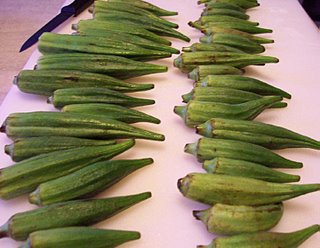 Besides a couple of very ripe mangos, some packages of dried bean curd sheets (haricot caillé séché en feuilles), and some sushi rice and sheets of roasted seaweed (algues séchées grillées) for making sushi rolls, I noticed a package of fresh okra (gombos). Being a reformed Southerner, I couldn't resist okra. What I had in mind was a nice pot of okra and tomatoes, using tomatoes from the garden. We ate okra and tomatoes when I was growing up in North Carolina.
Besides a couple of very ripe mangos, some packages of dried bean curd sheets (haricot caillé séché en feuilles), and some sushi rice and sheets of roasted seaweed (algues séchées grillées) for making sushi rolls, I noticed a package of fresh okra (gombos). Being a reformed Southerner, I couldn't resist okra. What I had in mind was a nice pot of okra and tomatoes, using tomatoes from the garden. We ate okra and tomatoes when I was growing up in North Carolina.
When I got home I looked in some of my Southern U.S. cookbooks to see what recipes for okra and tomatoes they might give. There were surprisingly few. In a book published by Southern Living magazine called Cooking Across the South (1980) there was something called Deep South Okra and Tomatoes, which included bacon, onion, cumin, and garlic along with the main ingredients.
But another recipe caught my eye. On the same page was a recipe for something called Okra Pilâu. Maybe it was the circumflex accent on that A that attracted me. Or the exotic name (how would you pronounce "pilâu" anyway?). The fact that the ingredients included green peppers as well as tomato and okra was also a plus. We have a lot of green and red bell peppers in the garden.
Red bell and long peppers
 I had red peppers from the garden. We decided early on not to pick the bell peppers while they were still green, but to wait until they turned red. And some had. They're better red, especially roasted, peeled, and marinated in olive oil.
I had red peppers from the garden. We decided early on not to pick the bell peppers while they were still green, but to wait until they turned red. And some had. They're better red, especially roasted, peeled, and marinated in olive oil.
Diced sweet red peppers
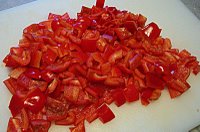 I also had tomatoes from the garden, and wanted to use them. Instead of putting them in to cook down into the sauce, I decided to add them at the last minute so they would be identifiable and fresh-tasting in the finished dish.
I also had tomatoes from the garden, and wanted to use them. Instead of putting them in to cook down into the sauce, I decided to add them at the last minute so they would be identifiable and fresh-tasting in the finished dish.
Roma tomatoes
 I also had a package of French supermarket lardons fumés — smoked bacon cut into matchstick shapes — so that was perfect. I sauteed the lardons in a little butter and oil until they started to brown.
I also had a package of French supermarket lardons fumés — smoked bacon cut into matchstick shapes — so that was perfect. I sauteed the lardons in a little butter and oil until they started to brown.
Meanwhile, I cut the tops off the okra pods and cut the pods into slices.
Okra and bacon (lardons fumés)
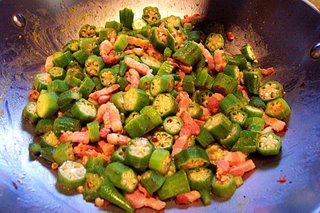 Then I added the okra to the lardons and let all that cook together for a few minutes. It started to stick, so I added a few tablespoons of water and let it continue to cook on low heat.
Then I added the okra to the lardons and let all that cook together for a few minutes. It started to stick, so I added a few tablespoons of water and let it continue to cook on low heat.
Then it was time to add the chopped onions and red peppers. All that cooked slowly for a while. I wanted the onions and peppers to be tender but not overcooked, and I wanted to make sure the okra got good and soft, because the pods contained a lot of seeds and can be a little fibrous. Then I poured in some good chicken stock I had made the day before, using the back and trimmings from the chicken that I had cooked as a tajine with prunes. The stock was flavored with fresh ginger, garlic, onion, bay leaves, parsley stems, a clove, and some black peppercorns.
Okra, bacon, onions, peppers, and tomatoes
 Finally, I added the diced tomatoes and let them heat through. The okra and bacon were well cooked, the peppers and onions were tender but not disintegrating, and the tomatoes were just warm.
Finally, I added the diced tomatoes and let them heat through. The okra and bacon were well cooked, the peppers and onions were tender but not disintegrating, and the tomatoes were just warm.
At the last minute, I remembered that I had seen a ziploc bag of tiny bay shrimp in the freezer the day before. I rummaged through the freezer, found the shrimp, and added them at the very last minute. They just had time to cook through.
While all this was going on, I had cooked 1½ cups of basmati rice in 3 cups of the ginger- and garlic-flavored chicken stock. I had decided not to cook the okra-peppers-tomato mix with the rice because the vegetables would end up overdone. I told Walt we would treat it as a vegetable stir-fry and serve it over the rice. I supposed that meant it wasn't really a pilâu, but it was good nonetheless.
Fresh okra from Tang Frères in Paris
 Besides a couple of very ripe mangos, some packages of dried bean curd sheets (haricot caillé séché en feuilles), and some sushi rice and sheets of roasted seaweed (algues séchées grillées) for making sushi rolls, I noticed a package of fresh okra (gombos). Being a reformed Southerner, I couldn't resist okra. What I had in mind was a nice pot of okra and tomatoes, using tomatoes from the garden. We ate okra and tomatoes when I was growing up in North Carolina.
Besides a couple of very ripe mangos, some packages of dried bean curd sheets (haricot caillé séché en feuilles), and some sushi rice and sheets of roasted seaweed (algues séchées grillées) for making sushi rolls, I noticed a package of fresh okra (gombos). Being a reformed Southerner, I couldn't resist okra. What I had in mind was a nice pot of okra and tomatoes, using tomatoes from the garden. We ate okra and tomatoes when I was growing up in North Carolina.When I got home I looked in some of my Southern U.S. cookbooks to see what recipes for okra and tomatoes they might give. There were surprisingly few. In a book published by Southern Living magazine called Cooking Across the South (1980) there was something called Deep South Okra and Tomatoes, which included bacon, onion, cumin, and garlic along with the main ingredients.
But another recipe caught my eye. On the same page was a recipe for something called Okra Pilâu. Maybe it was the circumflex accent on that A that attracted me. Or the exotic name (how would you pronounce "pilâu" anyway?). The fact that the ingredients included green peppers as well as tomato and okra was also a plus. We have a lot of green and red bell peppers in the garden.
Red bell and long peppers
 I had red peppers from the garden. We decided early on not to pick the bell peppers while they were still green, but to wait until they turned red. And some had. They're better red, especially roasted, peeled, and marinated in olive oil.
I had red peppers from the garden. We decided early on not to pick the bell peppers while they were still green, but to wait until they turned red. And some had. They're better red, especially roasted, peeled, and marinated in olive oil.Diced sweet red peppers
 I also had tomatoes from the garden, and wanted to use them. Instead of putting them in to cook down into the sauce, I decided to add them at the last minute so they would be identifiable and fresh-tasting in the finished dish.
I also had tomatoes from the garden, and wanted to use them. Instead of putting them in to cook down into the sauce, I decided to add them at the last minute so they would be identifiable and fresh-tasting in the finished dish.Roma tomatoes
 I also had a package of French supermarket lardons fumés — smoked bacon cut into matchstick shapes — so that was perfect. I sauteed the lardons in a little butter and oil until they started to brown.
I also had a package of French supermarket lardons fumés — smoked bacon cut into matchstick shapes — so that was perfect. I sauteed the lardons in a little butter and oil until they started to brown.Meanwhile, I cut the tops off the okra pods and cut the pods into slices.
Okra and bacon (lardons fumés)
 Then I added the okra to the lardons and let all that cook together for a few minutes. It started to stick, so I added a few tablespoons of water and let it continue to cook on low heat.
Then I added the okra to the lardons and let all that cook together for a few minutes. It started to stick, so I added a few tablespoons of water and let it continue to cook on low heat.Then it was time to add the chopped onions and red peppers. All that cooked slowly for a while. I wanted the onions and peppers to be tender but not overcooked, and I wanted to make sure the okra got good and soft, because the pods contained a lot of seeds and can be a little fibrous. Then I poured in some good chicken stock I had made the day before, using the back and trimmings from the chicken that I had cooked as a tajine with prunes. The stock was flavored with fresh ginger, garlic, onion, bay leaves, parsley stems, a clove, and some black peppercorns.
Okra, bacon, onions, peppers, and tomatoes
 Finally, I added the diced tomatoes and let them heat through. The okra and bacon were well cooked, the peppers and onions were tender but not disintegrating, and the tomatoes were just warm.
Finally, I added the diced tomatoes and let them heat through. The okra and bacon were well cooked, the peppers and onions were tender but not disintegrating, and the tomatoes were just warm.At the last minute, I remembered that I had seen a ziploc bag of tiny bay shrimp in the freezer the day before. I rummaged through the freezer, found the shrimp, and added them at the very last minute. They just had time to cook through.
While all this was going on, I had cooked 1½ cups of basmati rice in 3 cups of the ginger- and garlic-flavored chicken stock. I had decided not to cook the okra-peppers-tomato mix with the rice because the vegetables would end up overdone. I told Walt we would treat it as a vegetable stir-fry and serve it over the rice. I supposed that meant it wasn't really a pilâu, but it was good nonetheless.
05 September 2006
Tajine of chicken and prunes
When I got up this morning at 7:00, I looked out the bedroom window and saw thick fog hanging in the still air out over the vineyard. It was warm yesterday — the temperature hit 26.5ºC, about 80ºF, and weather reports say it will hit 30ºC today, or 86ºF. Good. We haven't had any hot weather since July.
Now at 9:00 a.m. the sun is shining brightly, the fog has burned off, and the sky is blue. It's beautiful. And what are our plans for the day? We need to saw some logs down to the size that will fit into our new woodstove so that we will be able to have nice fires when the weather turns cold and rainy in November.
Meanwhile, a few days ago I mentioned that I was going to make a tajine of chicken with prunes and almonds over the weekend. I did, on Saturday. Here's how it turned out.
I decided to serve it with boiled potatoes rather than rice, because I was planning to make a rice pilaf with okra the next day. Besides, I had a sack of red potatoes in the cellar that needed to be used. This dish would also be good served with couscous grain.
I love to cook with prunes. At one company I worked for in Silicon Valley, there was a woman named Ellen (hi, Ellen!) whose family had been in the plum-growing business in California. We often traded recipes, and all of us in our workgroup joked about the marketing decision to call California prunes "dried plums" because prunes have an image problem in the U.S.
Americans think prunes are food for old people. Did you know that in France they are considered a fine delicacy, and in Japan they are considered a miracle food? Many of the prunes sold in France these days come from California, but the best French ones come from the town of Agen in southwest France, not too far from Bordeaux. In French, plums are called prunes and prunes are called pruneaux.
I love to cook rabbit, lamb, pork, and poultry with prunes. Plum jam is my favorite confiture. Later today, I'm planning to drive ten miles south from Saint-Aignan to pick plums in a friend's orchard. If I get enough, I'll make jam.
The recipe or idea for a tajine of chicken with prunes was mine, and then I found this recipe on the 1001 Délices web site. Here's my translation.
Tajine of chicken with plums, zucchini, and almonds
Ingredients:
8 chicken drumsticks
1 bowl of prunes (dried plums)
1 cup of whole almonds
1 tbs. of honey
3 zucchini (courgettes)
4 tbs. ras-el-hanout spice mixture*
1 tbs. lemon zest
2 large onions
Instructions:
Brown the chicken in a little oil. Add the onions cut into rings. Then add the ras-el-hanout spice mixture* and stir everything together so that the spices coat the chicken pieces.
Add the water, the prunes, the lemon zest, the almonds, and the honey. Let it cook on very low heat for 40 minutes.
Then add the zucchini cut into fairly thick rounds. Let it simmer for another 25 minutes to make sure the zucchini is cooked.
Serve with couscous grain or with boiled potatoes.
* Ras-el-hanout (sometimes spelled raz-el-hanout) is a
blend of various spices, sometimes up to 25 of them.
The ras-el-hanout I have is made of ground turmeric,
cumin, ginger, nutmeg, coriander, and cardamom. You
could easily make your own, or use curry powder.
Here's a list of my modifications and some pictures:
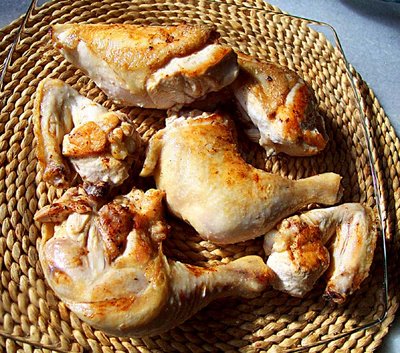 The recipe calls for 8 chicken drumsticks but I had and used a whole chicken cut into 6 pieces. Walt likes the chicken breast, and so do I. I left the thigh/drumstick sections whole, and they made a second meal for us as leftovers. It was really better the second time around, by the way.
The recipe calls for 8 chicken drumsticks but I had and used a whole chicken cut into 6 pieces. Walt likes the chicken breast, and so do I. I left the thigh/drumstick sections whole, and they made a second meal for us as leftovers. It was really better the second time around, by the way.
 The recipe calls for two large onions, but I had four small ones. In general, French onions are smaller than American ones. You could use shallots, and I think it would also be good with some garlic in it.
The recipe calls for two large onions, but I had four small ones. In general, French onions are smaller than American ones. You could use shallots, and I think it would also be good with some garlic in it.
 The recipe calls for 4 tbs. of the spice mixture, and that's what I put in. I think it was too much. Half the amount would have been plenty, in my opinion. (And I wouldn't have wasted so much ras-el-hanout, which is hard to find.) I also added a dash of cayenne pepper and a pinch of cinnamon to the spice mixture I had.
The recipe calls for 4 tbs. of the spice mixture, and that's what I put in. I think it was too much. Half the amount would have been plenty, in my opinion. (And I wouldn't have wasted so much ras-el-hanout, which is hard to find.) I also added a dash of cayenne pepper and a pinch of cinnamon to the spice mixture I had.
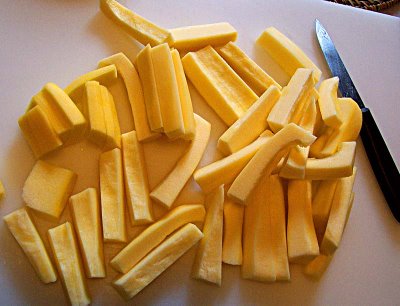 I had one monster yellow crookneck squash from the garden, so I used that instead of zucchini. I peeled it, cut it in half the long way, and scraped out the seeds with a spoon. I cut the squash flesh into fairly thick sticks.
I had one monster yellow crookneck squash from the garden, so I used that instead of zucchini. I peeled it, cut it in half the long way, and scraped out the seeds with a spoon. I cut the squash flesh into fairly thick sticks.
 I didn't pit the prunes because I wanted them to remain whole and not melt into the sauce. Just tell your guests or family that the pits are still in the prunes. The recipe calls for a very vague quantity of prunes. Use as many as you want. The more the better... within reason.
I didn't pit the prunes because I wanted them to remain whole and not melt into the sauce. Just tell your guests or family that the pits are still in the prunes. The recipe calls for a very vague quantity of prunes. Use as many as you want. The more the better... within reason.
And you might notice that I forgot to put in the almonds. I had planned to toast them in the oven and add them at the last minute so they would be toasty and crispy. We were already eating when Walt said: "I thought this was going to have almonds in it." Next time maybe I won't forget them.
Next time, also, I will use less spice and I will serve the tajine with couscous grain. And I think I'll make it with lamb instead of chicken.
Now at 9:00 a.m. the sun is shining brightly, the fog has burned off, and the sky is blue. It's beautiful. And what are our plans for the day? We need to saw some logs down to the size that will fit into our new woodstove so that we will be able to have nice fires when the weather turns cold and rainy in November.
Meanwhile, a few days ago I mentioned that I was going to make a tajine of chicken with prunes and almonds over the weekend. I did, on Saturday. Here's how it turned out.
I decided to serve it with boiled potatoes rather than rice, because I was planning to make a rice pilaf with okra the next day. Besides, I had a sack of red potatoes in the cellar that needed to be used. This dish would also be good served with couscous grain.
I love to cook with prunes. At one company I worked for in Silicon Valley, there was a woman named Ellen (hi, Ellen!) whose family had been in the plum-growing business in California. We often traded recipes, and all of us in our workgroup joked about the marketing decision to call California prunes "dried plums" because prunes have an image problem in the U.S.
Americans think prunes are food for old people. Did you know that in France they are considered a fine delicacy, and in Japan they are considered a miracle food? Many of the prunes sold in France these days come from California, but the best French ones come from the town of Agen in southwest France, not too far from Bordeaux. In French, plums are called prunes and prunes are called pruneaux.
I love to cook rabbit, lamb, pork, and poultry with prunes. Plum jam is my favorite confiture. Later today, I'm planning to drive ten miles south from Saint-Aignan to pick plums in a friend's orchard. If I get enough, I'll make jam.
The recipe or idea for a tajine of chicken with prunes was mine, and then I found this recipe on the 1001 Délices web site. Here's my translation.
Tajine of chicken with plums, zucchini, and almonds
Ingredients:
8 chicken drumsticks
1 bowl of prunes (dried plums)
1 cup of whole almonds
1 tbs. of honey
3 zucchini (courgettes)
4 tbs. ras-el-hanout spice mixture*
1 tbs. lemon zest
2 large onions
Instructions:
Brown the chicken in a little oil. Add the onions cut into rings. Then add the ras-el-hanout spice mixture* and stir everything together so that the spices coat the chicken pieces.
Add the water, the prunes, the lemon zest, the almonds, and the honey. Let it cook on very low heat for 40 minutes.
Then add the zucchini cut into fairly thick rounds. Let it simmer for another 25 minutes to make sure the zucchini is cooked.
Serve with couscous grain or with boiled potatoes.
* Ras-el-hanout (sometimes spelled raz-el-hanout) is a
blend of various spices, sometimes up to 25 of them.
The ras-el-hanout I have is made of ground turmeric,
cumin, ginger, nutmeg, coriander, and cardamom. You
could easily make your own, or use curry powder.
Here's a list of my modifications and some pictures:
 The recipe calls for 8 chicken drumsticks but I had and used a whole chicken cut into 6 pieces. Walt likes the chicken breast, and so do I. I left the thigh/drumstick sections whole, and they made a second meal for us as leftovers. It was really better the second time around, by the way.
The recipe calls for 8 chicken drumsticks but I had and used a whole chicken cut into 6 pieces. Walt likes the chicken breast, and so do I. I left the thigh/drumstick sections whole, and they made a second meal for us as leftovers. It was really better the second time around, by the way. The recipe calls for two large onions, but I had four small ones. In general, French onions are smaller than American ones. You could use shallots, and I think it would also be good with some garlic in it.
The recipe calls for two large onions, but I had four small ones. In general, French onions are smaller than American ones. You could use shallots, and I think it would also be good with some garlic in it. The recipe calls for 4 tbs. of the spice mixture, and that's what I put in. I think it was too much. Half the amount would have been plenty, in my opinion. (And I wouldn't have wasted so much ras-el-hanout, which is hard to find.) I also added a dash of cayenne pepper and a pinch of cinnamon to the spice mixture I had.
The recipe calls for 4 tbs. of the spice mixture, and that's what I put in. I think it was too much. Half the amount would have been plenty, in my opinion. (And I wouldn't have wasted so much ras-el-hanout, which is hard to find.) I also added a dash of cayenne pepper and a pinch of cinnamon to the spice mixture I had. I had one monster yellow crookneck squash from the garden, so I used that instead of zucchini. I peeled it, cut it in half the long way, and scraped out the seeds with a spoon. I cut the squash flesh into fairly thick sticks.
I had one monster yellow crookneck squash from the garden, so I used that instead of zucchini. I peeled it, cut it in half the long way, and scraped out the seeds with a spoon. I cut the squash flesh into fairly thick sticks. I didn't pit the prunes because I wanted them to remain whole and not melt into the sauce. Just tell your guests or family that the pits are still in the prunes. The recipe calls for a very vague quantity of prunes. Use as many as you want. The more the better... within reason.
I didn't pit the prunes because I wanted them to remain whole and not melt into the sauce. Just tell your guests or family that the pits are still in the prunes. The recipe calls for a very vague quantity of prunes. Use as many as you want. The more the better... within reason.And you might notice that I forgot to put in the almonds. I had planned to toast them in the oven and add them at the last minute so they would be toasty and crispy. We were already eating when Walt said: "I thought this was going to have almonds in it." Next time maybe I won't forget them.
Next time, also, I will use less spice and I will serve the tajine with couscous grain. And I think I'll make it with lamb instead of chicken.
03 September 2006
Gratin d'aubergines et de tomates
This is my current version of what we used to call Eggplant Parmesan, but slimmed down and cleaned up.
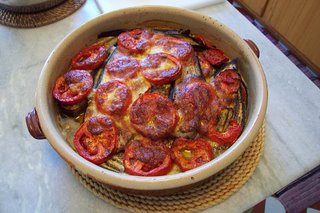
Back in the old days, you would slice the eggplants (aubergines in French and in British English), dip the slices in egg and breadcrumbs, and then fry them until they were soft and golden. That added a lot of fat to the dish. Eggplant Parmesan was made with eggplants, tomato sauce, and parmesan cheese.
At one point a few years ago I saw a French recipe that left out the breadcrumbs but still had you dip the eggplant slices in egg and fry them. I tried that once but I didn't think the egg added anything, and it ended up too rich and greasy.
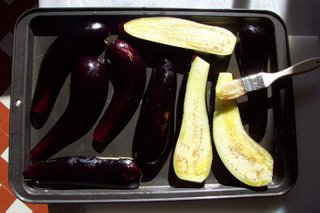
Nowadays, what I do is cut the eggplant into slices 1 cm or even 2 cm (about ½ in.) thick and lay them out on an oiled baking sheet. I use olive oil, and I use a brush to "paint" the exposed side of the eggplant slices with the oil. Then I put them into a hot oven (400ºF or 200ºC) for 15 or 20 minutes. I just have to watch them to make sure they are softening without getting too brown. The top of my oven seems to be a lot hotter than the bottom (c'est normal, non?) and when I made this the other day I had three pans in the oven at one time, on different levels. When the slices are done the way you want them, take them out and let them cool for a few minutes on the pans.
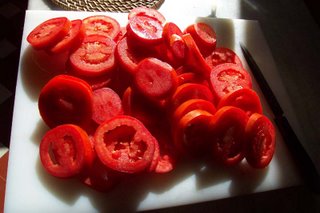
Meanwhile, slice some tomatoes and some mozzarella cheese. Crush and chop a couple of garlic cloves. Proportions don't matter much here — you need about as many layers of tomato as eggplant slices for the dish, and you can put in as much garlic as you like.
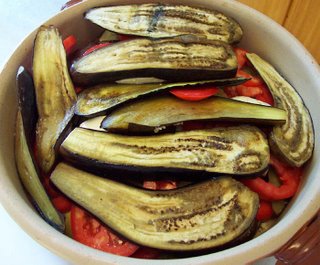
Put a thin layer of olive oil on the bottom of a baking dish. Remove the cooked slices of eggplant from the baking pans with a long spatula and put a layer of them in the bottom of the dish. Put a layer of tomato slices over them. Sprinkle in some salt and pepper, some of the chopped garlic, and a little thyme or other herbs to taste. Dribble on some olive oil if you want. Then put on some mozzarella slices — again, the amount of cheese is up to you. C'est vous qui voyez, comme on dit.
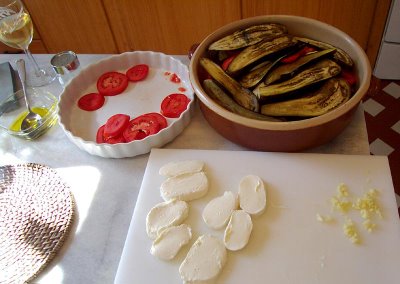 Slices of cooked eggplant, raw tomato, and mozzarella cheese,
Slices of cooked eggplant, raw tomato, and mozzarella cheese,
seasoned with garlic, herbs, and olive oil
Make two or even three layers this way. Finish with some slices of mozzarella so that it will brown on top. Put the dish in a hot oven (again, 200ºC) and let it cook until it's done the way you want it.
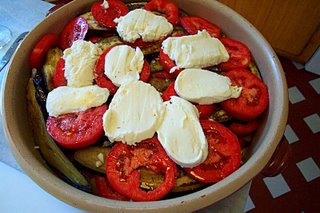
Depending on how cooked your eggplant slices are, and how cooked you want the tomatoes to be, you might leave it in the oven for 20 minutes or even 60 minutes. If you leave it as long as an hour, turn the oven down after 20 minutes or so so that it doesn't burn on top. If you want to, you can cover it after it's partially cooked and browned.
I covered mine after 20 minutes or so, and left it in the oven for an hour, turning the heat down to 160ºC (about 300ºF) when I put the cover on. I was using Roma tomatoes (olivettes) and they were ripe but not very juicy, so I wanted them to cook for a while. And I wanted to make sure the thickest eggplant slices were thoroughly cooked.
The finished dish contained a fair amount of liquid, which happens when you cook eggplant or zucchini in the oven. What I did was use a turkey baster to draw off the liquid (it was a good-flavored broth with some olive oil floating on top), put it in a bowl, and serve it alongside the gratin. You could spoon it on as desired on your plate.

Back in the old days, you would slice the eggplants (aubergines in French and in British English), dip the slices in egg and breadcrumbs, and then fry them until they were soft and golden. That added a lot of fat to the dish. Eggplant Parmesan was made with eggplants, tomato sauce, and parmesan cheese.
At one point a few years ago I saw a French recipe that left out the breadcrumbs but still had you dip the eggplant slices in egg and fry them. I tried that once but I didn't think the egg added anything, and it ended up too rich and greasy.

Nowadays, what I do is cut the eggplant into slices 1 cm or even 2 cm (about ½ in.) thick and lay them out on an oiled baking sheet. I use olive oil, and I use a brush to "paint" the exposed side of the eggplant slices with the oil. Then I put them into a hot oven (400ºF or 200ºC) for 15 or 20 minutes. I just have to watch them to make sure they are softening without getting too brown. The top of my oven seems to be a lot hotter than the bottom (c'est normal, non?) and when I made this the other day I had three pans in the oven at one time, on different levels. When the slices are done the way you want them, take them out and let them cool for a few minutes on the pans.

Meanwhile, slice some tomatoes and some mozzarella cheese. Crush and chop a couple of garlic cloves. Proportions don't matter much here — you need about as many layers of tomato as eggplant slices for the dish, and you can put in as much garlic as you like.

Put a thin layer of olive oil on the bottom of a baking dish. Remove the cooked slices of eggplant from the baking pans with a long spatula and put a layer of them in the bottom of the dish. Put a layer of tomato slices over them. Sprinkle in some salt and pepper, some of the chopped garlic, and a little thyme or other herbs to taste. Dribble on some olive oil if you want. Then put on some mozzarella slices — again, the amount of cheese is up to you. C'est vous qui voyez, comme on dit.
 Slices of cooked eggplant, raw tomato, and mozzarella cheese,
Slices of cooked eggplant, raw tomato, and mozzarella cheese,seasoned with garlic, herbs, and olive oil
Make two or even three layers this way. Finish with some slices of mozzarella so that it will brown on top. Put the dish in a hot oven (again, 200ºC) and let it cook until it's done the way you want it.

Depending on how cooked your eggplant slices are, and how cooked you want the tomatoes to be, you might leave it in the oven for 20 minutes or even 60 minutes. If you leave it as long as an hour, turn the oven down after 20 minutes or so so that it doesn't burn on top. If you want to, you can cover it after it's partially cooked and browned.
I covered mine after 20 minutes or so, and left it in the oven for an hour, turning the heat down to 160ºC (about 300ºF) when I put the cover on. I was using Roma tomatoes (olivettes) and they were ripe but not very juicy, so I wanted them to cook for a while. And I wanted to make sure the thickest eggplant slices were thoroughly cooked.
The finished dish contained a fair amount of liquid, which happens when you cook eggplant or zucchini in the oven. What I did was use a turkey baster to draw off the liquid (it was a good-flavored broth with some olive oil floating on top), put it in a bowl, and serve it alongside the gratin. You could spoon it on as desired on your plate.
01 September 2006
September: a beautiful beginning
Today was perfect. The sun shone brightly, there was little or no wind, and the temperature hit 26.5ºC — that's about 80ºF. It was a nice day in Saint-Aignan. I got up at about 8:30 and washed some dishes. I drank a cup of tea and then went downstairs and took a load of laundry out of the machine. I hung it out on the line to dry — conditions were perfect for that.
At about 10:20 the bread lady came by and I bought a baguette. Then I drove over to the Ed store to buy some things — butter, milk, cheese, onions, walnuts, raisins, dishwashing detergent, and a chicken. I also bought some steaks and for lunch we had the French national dish, steak-frites (steak and French-fried potatoes), with a green salad and that good baguette. Along with some good Touraine gamay red wine from our local winemaker, Bruno Denis of the Domaine de la Renaudie.
Meanwhile, back in my home town in North Carolina, tropical storm Ernesto rolled ashore with moderate winds and heavy rains. Some localities got as much as eight inches — that's 200 mm — of rainfall. Here in Saint-Aignan, we had 50 mm, or two inches, of rain in all the month of August.
This day of nice weather is making me optimistic about September, but only time will tell whether this month's weather will be better than the last's. News reports here are saying that northern France just lived through it's chilliest August in 20 years. It wasn't frankly unpleasant here in Saint-Aignan, but Walt did build a fire in the woodstove one morning this week.
This will be a quiet weekend. Walt's going to see Mme Barbier for a haircut tomorrow. Today on the Internet I found a recipe for a tajine of chicken with prunes, zucchini, and almonds. If it turns out to be good, I'll post the recipe and some pictures on Sunday or Monday. The recipe is in French but I'll put up an English version.
Walt is upstairs right now making a tart with some pears off the tree in our side yard. That'll have to be supper.
Walt is upstairs right now making a tart with some pears off the tree in our side yard. That'll have to be supper.
Subscribe to:
Posts (Atom)





